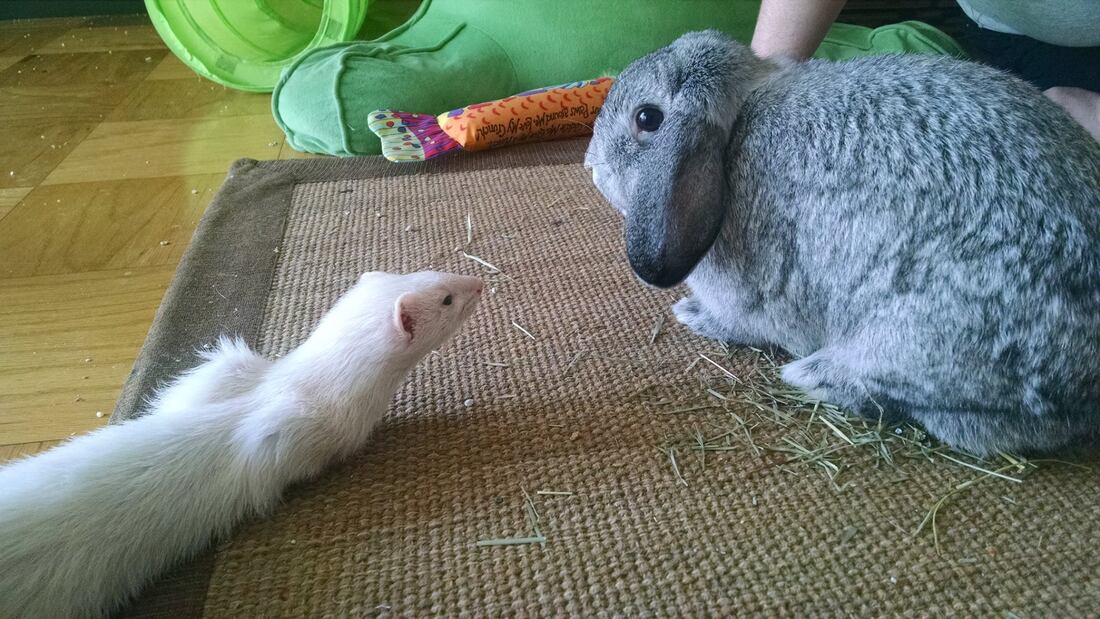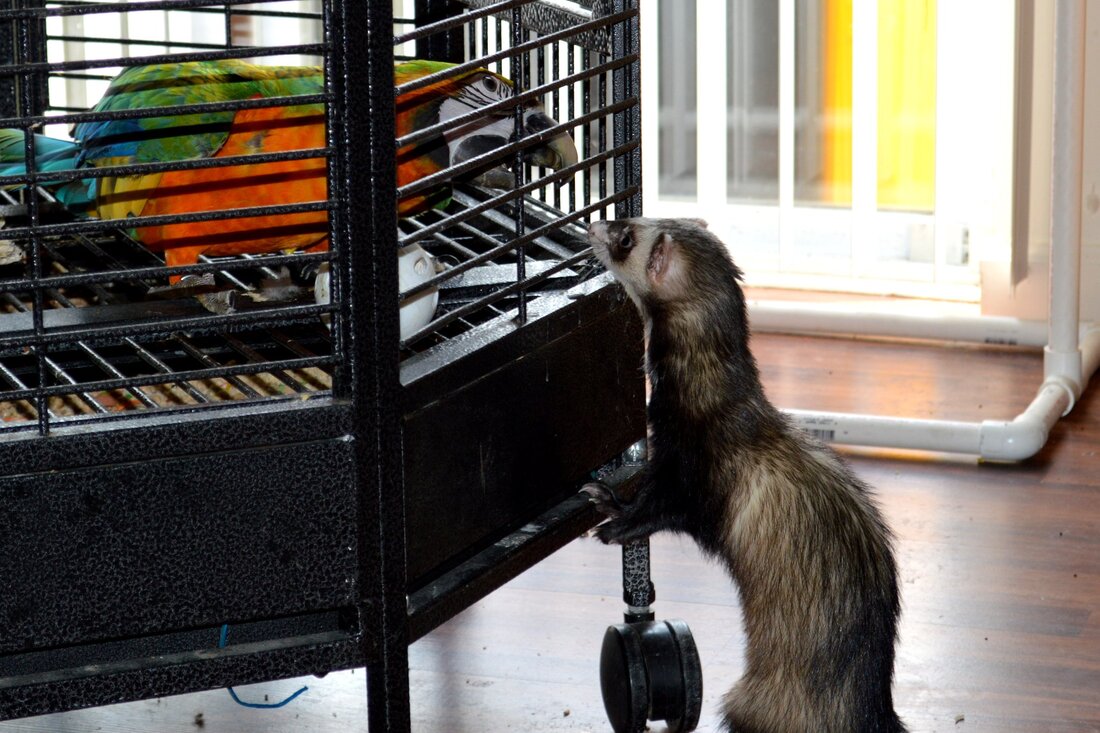|
We often get asked about whether it is possible to have a pet ferret if you also have a pet bunny, rodent, or parrot in the home. There are many stories about pet ferrets causing injury or even death to other pets, but these accidents are preventable. In this series, we are going to discuss different elements that you should be aware of before you mix a pet ferret with other prey type pets. This is the third part of this series. You can find links to the other parts down below. In the first part we already discussed the biology and domestication process of ferrets. In the second part we discussed how to make your other animal friend safe and comfortable. Now, we are going to focus on the ferrets. In the predator/prey relationship between ferrets and other types of pets, most of the concerns about stress and safety falls on the prey type animal in the equation. For the most part, ferrets are not going to be stressed by the smell of prey type animals. Most of the smells and movements are interesting to ferrets, not scary. However, there is one type of pet that can cause stress for your pet ferret and those are birds. Remember in the first part when we discussed ferret’s hearing? There are certain high pitch sounds that cause distress in ferrets. We do not know if it is because the sound is similar to a crying kit, the cries of an injured ferret, or if the sound physically causes pain or discomfort. Birds are sometimes capable of making these high pitch sounds which are distressing for some ferrets. In our experience, it has always been female ferrets who have this problem. We resolve this by using a white noise machine in the room where the ferrets sleep. For whatever reason, this seems to work. Other risks to your ferret can include having their noses or toes bitten by other pets when they insert these body parts between cage bars as they attempt to get access to the other animal. If the other animal is trying to protect its territory and is interacting with the ferret through the cage bars, the ferret may be able to bite part of the animal and try to pull its body through the cage bar doing damage in the process. Cages that have tight bar spacing are not a safe barrier between a ferret and your other pet. Large pets such as pet macaws or bunnies can also inflict serious damage on a pet ferret. Animals like hedgehogs may seem like they are able to protect themselves, but interacting with a ferret can be extremely stressful for the hedgehog and it also poses a risk of salmonella for the ferret. This risk of salmonella is why it is advised for people to not kiss their hedgehogs and to wash their hands after handling. If ferrets are permitted to interact with other animals, there are behavioral cues that can easily be misread. Most videos that people have seen of a predatory animal attacking a prey animal are usually ambush predators such as cats or pack hunters such as dogs and wolves. Members of the weasel family have a different hunting style that is not as immediately recognizably. To give an example, we are showing you two clips involving the same ferret with two different types of animals. The first clip shows Samson with a young kitten, Peach. Here the risk of predator drift is low because the kitten does not smell like a prey type of animal. You will see that he is mostly grooming her ears and his demeanor is relaxed. He is not fixated on grooming any particular spot. Now we will compare this video with a video of the same ferret, Samson, grooming a rat. Here, the risk of predator drift is higher because both the scent and the movement of the animal are triggering. Notice the increased urgency and attention in his grooming. He also begins to focus on the neck. This is where the predatory drift starts to occur. Did you notice the difference? The predatory style of ferrets is investigative, calm, and persistent. If the prey animal runs or fights back, the ferret is capable of pursuing or subduing. But unsuspecting prey are like a frog in a pot of water in which the temperature is slowly increased and they are unaware of the risk until it is too late. As you saw in the video with Samson, his instinct was to find the right spot to hold onto the neck and if permitted to continue the interaction, he would have clamped down and tried to subdue his prey. This same behavior can also happen in introductions between ferrets, particularly between adult ferrets and young kits. If you see this happening, the good news is that there is time to intervene. If the ferret is able to clamp down, in a lot of cases it does not immediately result in injury or death, especially if this interaction happens between two ferrets. You can scruff the attacking ferret with one hand and use the other hand to encourage the attacking ferret to let go. If you can remain calm, this will make you more successful. You do not want to add your elevated energy to cause the other animal to panic or to further push the ferret into its predatory response. The safest option is not allow your ferret to interact directly with your other pet. You also want to make sure that the other pet is as uninteresting as possible. If your ferret is constantly receiving new enrichment, new stimulation, and new challenges, then it won’t need to create a new challenge for itself in trying to get access to an animal that it has already decided is boring. You want to have the opposite situation that you are making for the prey type animal. You want the ferrets to have constant access to the smells and sounds of the other animal. Having a common play area is one way, but you can also take things from the other animals and bring them into the ferret's space. For example, you can leave a blanket with bunnies to get their scent all over and then give it to the ferrets to sleep in. When your parrots molt feathers, use the molted feathers as scent exposure for the ferrets. Do not make a fuss over the blanket or the feathers. Do not encourage your ferret to play with these items. When your ferrets treat these things as boring and uninteresting, you know that you are doing well in desentizing them.
Finally, I want to take a moment to discuss temperament. In my experience, fearful or nervous ferrets tend to have higher risk in acting on predatory impulses. My theory is that they have lower impulse control with their instincts. You may think that because they run and hide when a stranger walks into a room that they would act fearfully towards your new pet bunny, but the opposite is more likely the case. These ferrets are more likely to attack than retreat towards an animal that triggers that predatory script. On the opposite end of the spectrum, we have had some incredibly sweet deaf ferrets that are usually slower to process information in their environment. They tend to be more naturally disinterested in prey type animals and they tend to retreat when they are unsure about what is happening. I suspect that they learn to respond this way because they have less stimulation that would trigger a predatory response by the lack of sound and they also learn to respond more slowly to novel stimuli in general. The final group I want to discuss are our complete love bugs. Ferrets like these are hard to imagine as efficient murder machines. How they act with people is not a good predictor for how they will act towards other animals. The same thing happens with dogs. I would encourage people to exercise even more caution with their absolute sweethearts. The reason for this is that we need to compensate for our own bias. Some of these ferrets might be gentle with animals of other species, while others will not. Your bias and assumption of their gentleness may cause you to miss cues that indicate that your cuddle bug is capable of hurting your other pets. In our next post we will be discussing more advanced training techniques to use with ferrets for the purpose of desensitization and delay of the predatory response.
2 Comments
12/15/2023 10:31:00 pm
Wow! Your site is amazing. Please visit our website. Thanks
Reply
Leave a Reply. |
About the blogFerrets and Friends, LLC has four writers bringing you information on a variety of topics from pets to wildlife, education to conservation, and from new developments in our business to information about our industry. Learn something new each week! Archives
August 2020
Categories
All
|


 RSS Feed
RSS Feed